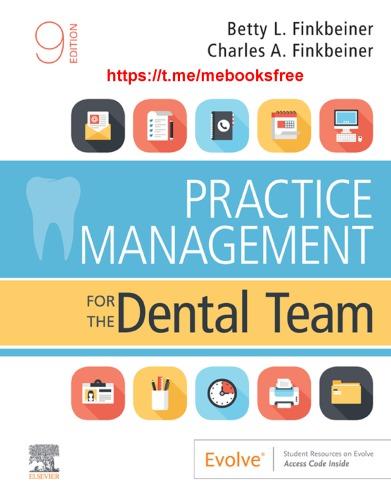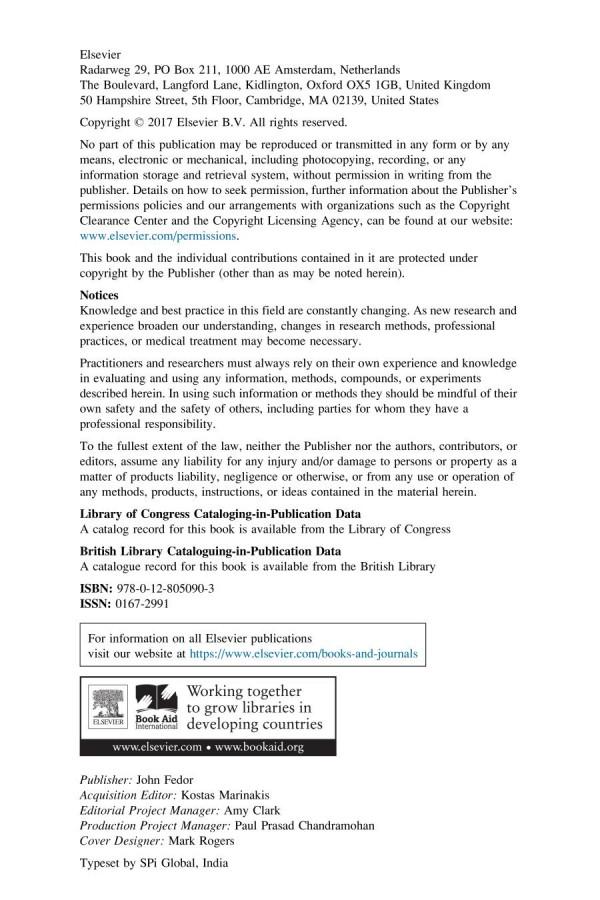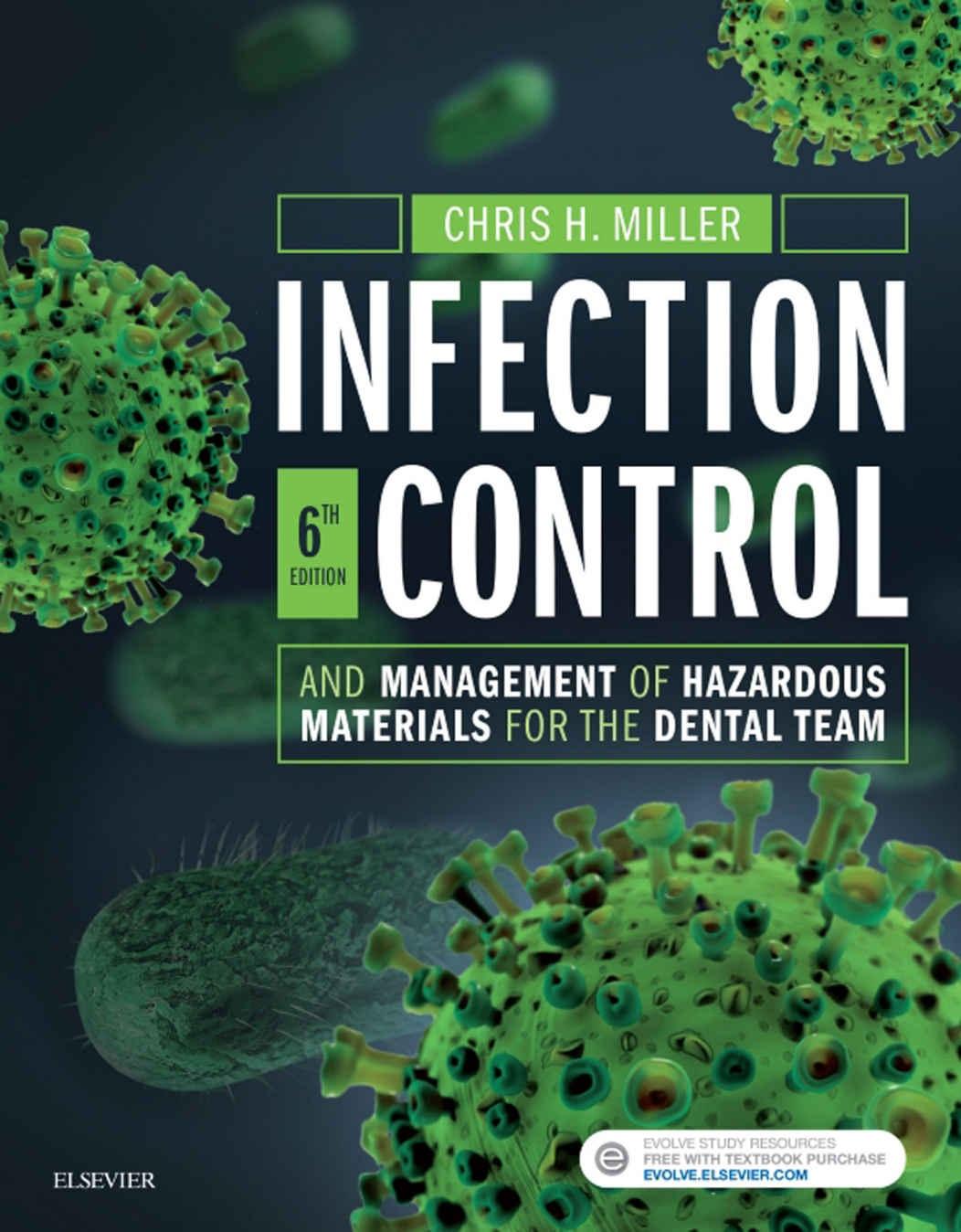Visit to download the full and correct content document: https://ebookmass.com/product/infection-control-and-management-of-hazardous-mat erials-for-the-dental-team/

More products digital (pdf, epub, mobi) instant download maybe you interests ...

Practice Management for the Dental Team 9th Edition
Edition Betty Ladley Finkbeiner
https://ebookmass.com/product/practice-management-for-the-dentalteam-9th-edition-edition-betty-ladley-finkbeiner/

Dental
Materials: Clinical Applications for
and Hygienists 3rd
Assistants
https://ebookmass.com/product/dental-materials-clinicalapplications-for-assistants-and-hygienists-3rd/

Hazardous and Trace Materials in Soil and Plants M. Naeem
https://ebookmass.com/product/hazardous-and-trace-materials-insoil-and-plants-m-naeem/

Ethics, Jurisprudence and Practice Management in Dental Hygiene (Kimbrough, Ethics, Juriprudence and Practice Management in Dental Hygiene) – Ebook PDF Version
https://ebookmass.com/product/ethics-jurisprudence-and-practicemanagement-in-dental-hygiene-kimbrough-ethics-juriprudence-andpractice-management-in-dental-hygiene-ebook-pdf-version/

Morphological, Compositional, and Shape Control of Materials for Catalysis 1st Edition Edition Paolo Fornasiero And Matteo Cargnello (Eds.)
https://ebookmass.com/product/morphological-compositional-andshape-control-of-materials-for-catalysis-1st-edition-editionpaolo-fornasiero-and-matteo-cargnello-eds/

Tutorial Topics in Infection for the Combined Infection Training Programme 1st Edition Cheuk Yan William Tong
https://ebookmass.com/product/tutorial-topics-in-infection-forthe-combined-infection-training-programme-1st-edition-cheuk-yanwilliam-tong/

Planning and Control of Land Development: Cases and Materials, Ninth Edition – Ebook PDF Version
https://ebookmass.com/product/planning-and-control-of-landdevelopment-cases-and-materials-ninth-edition-ebook-pdf-version/

Nanohybrid and Nanoporous Materials for Aquatic Pollution Control (Micro and Nano Technologies) 1st Edition Lin Tang (Editor)
https://ebookmass.com/product/nanohybrid-and-nanoporousmaterials-for-aquatic-pollution-control-micro-and-nanotechnologies-1st-edition-lin-tang-editor/

Adult Oral Health : Dental Care and Tips for Adults : Dental Care John Baggett
https://ebookmass.com/product/adult-oral-health-dental-care-andtips-for-adults-dental-care-john-baggett/

Handpiece Asepsis
Sterilization of Heat-Labile Items
Other Methods of Sterilization
Sterilization of Prion-Contaminated Instruments
Properties of Decontamination and Sterilization Equipment and Products
Review Questions
Selected Readings
14 Surface and Equipment Asepsis
Types of Environmental Surfaces
Surface Barriers
Precleaning and Disinfection
Equipment Decontamination
Aseptic Distribution of Dental Supplies
Review Questions
Selected Readings
15 Dental Unit Water Asepsis and Air Quality
Dental Unit Water
Presence of Microorganisms in Dental Unit Water
Types and Importance of Microorganisms in Dental Unit Water
Biofilm in Dental Water Lines
Need to Improve Dental Unit Water Quality
Current Infection Control Recommendations
Dental Unit Water and Infection Control
Approaches to Improve Dental Unit Water Quality
Water Quality Monitoring
Boil-Water Notices
Backflow Prevention
Dental Unit Air
Review Questions
Selected Readings
16 Aseptic Techniques
Touching of As Few Surfaces As Possible
Minimization of Dental Aerosols and Spatter
High-Volume Evaculation
Saliva Ejector
Use of the Rubber Dam
Preprocedure Mouth Rinse
Use of Disposables
Safe Injection Practices
Housekeeping and Cleaning
Other Aseptic Techniques
Review Questions
Selected Readings
17 Laboratory and Radiographic Asepsis
Laboratory Asepsis
Radiographic Asepsis
Review Questions
Selected Readings
18 Waste Management
Comprehensive Waste Management Plan
Types of Waste
Infectious Waste Management
Blood in a Liquid or Semiliquid Form
Pathogenic Waste (Teeth and Other Tissues)
Sharps
Review Questions
Selected Readings
19 Sharps Safety
Risks From Sharps Injuries
When Can Injuries Occur?
Prevention of Sharps Injuries
Safe Injection Practices
Review Questions
Selected Readings
20 Asepsis Protocols, SOPs, and Checklists
Safety Culture
Behind the Scenes
General Preparation
Before Seating the Patient
After Seating the Patient
During Patient Treatment
After Patient Treatment
Radiographic Asepsis
Laboratory Asepsis
Review Questions
Selected Readings
21 General Office Safety and Asepsis
Be Prepared
The Reception Area
Contamination From Outside
Walk Throughs
Review Questions
Selected Readings
22
Greener Infection Control
Going Green
Adverse Environmental Impacts
Recycling and Biodegradation
Green Indicators
Evaluating Specific Infection Control Procedures
Summary of Procedures for Greener Infection Prevention
Final Comments and Futuristic Thinking
Review Questions
Selected Readings
23 Cross-Contamination Between Work and Home
Routes of Spread From the Office to Home
Routes of Spread From Home to the Office
Review Questions
Selected Readings
Part III Office Safety
24 The Occupational Safety and Health Administration
Mission of the Occupational Safety and Health Administration
Purposes of the Occupational Safety and Health Administration
Coverage of the OSHA Act
Standards
Standards Development
State Safety and Health Programs
Department of Labor 2014 to 2018 Strategic Plan
Strategic Challenges
Review Questions
Selected Readings
25 OSHA Inspections
About OSHA
Inspection Priorities
What Does the Inspection Process Involve?
What Are the Possible Outcomes of an Inspection?
Proactive Thinking
Review Questions
Selected Readings
26 Management of the Office Safety Program
Infection Control Coordinator
Management Duties
Development of Standard Operating Procedures (SOPs)
Evaluation of the Infection Control Program
Review Questions
Selected Readings
27 Managing Chemicals Safely
Hazard Communication Program
Statement of the Problem
Occupational Safety and Health Administration
Hazard Communication Standard
Hazard Classification
Written Hazard Communication Program
Inventory and Listing of Hazardous Chemicals
Labels and Other Forms of Warning
Safety Data Sheets (Formerly Known As Material Safety Data Sheets)
Employee Information and Training
Trade Secrets
How the Occupational Safety and Health Administration Solves a Problem
Occupational Exposure to Hazardous Chemicals in Laboratories
Compliance
General Principles for Working With Laboratory Chemicals
Chemical Hygiene Responsibilities
Laboratory Facilities
Chemical Hygiene Plan
Working With Chemicals
Safety Recommendations
Review Questions
Selected Readings
28 Employee Fire Prevention and Emergency Action Plans
29 CFR Parts 1910.38 and 1910.39
Fire Prevention Plans
Emergency Action Plans
Alcohol-Based Hand Rub Solutions
Review Questions
Selected Readings
29 Infection Control Concerns During Remodeling or Construction
Statement of the Problem
Strategic Planning
Making Construction Policy
Construction and Remodeling
Moving In
Review Questions
Selected Readings
30 Transmission of Pathogens in Dental Settings
Transmission of Herpes Virus in a Dental Setting in the United States
Transmission of Pseudomonas aeruginosa to Dental Patients in England
Transmission of Legionella pneumophila to a Dental Patient in Italy
Transmission of Hepatitis B in Dental Settings
Spread of Hepatitis B From Patient to Patient in the United States
Transmission of Hepatitis C Virus From Patient to Patient in Oklahoma
Transmission of HIV to Dental Patients
Transmission of Waterborne Mycobacterium abscessus to Pediatric Dental Patients
Other Infection Control Breaches
Review Questions
Selected Readings
Appendix A Infection Control and Hazardous Materials Management Resource List
Dental-Related Organizations
Infection Control Organizations
Other Infection Control Websites
Federal Agencies
States With OSHA-Approved Programs
Appendix B CDC Guidelines for Infection Control in Dental Health Care Settings—2003
Recommendations
Reference
Appendix C CDC Guidelines for Prevention of Tuberculosis in Dental Settings
Guidelines for Preventing the Transmission of Mycobacterium Tuberculosis in Health Care Settings, 2005‡
Appendix D Organization for Safety, Asepsis, and Prevention
Mission Statement
OSAP's Vision
OSAP's Guiding Principles
Membership
Programs and Products
Appendix E Exposure Incident Report
Appendix F Infection Control and the American Dental Association (ADA)
Summary of the ADA's Statement on Infection Control*
Appendix G The Occupational Safety and Health Administration Bloodborne Pathogens Standard*
XI The Standard Part 1910-[Amended]
Appendix H The Occupational Safety and Health Administration Hazard Communication/Globally Harmonized System Regulatory Text—2012*
Glossary
Index
Copyright
3251 Riverport Lane
St. Louis, Missouri 63043
INFECTION CONTROL AND MANAGEMEMT OF HAZARDOUS MATERIALS FOR THE DENTAL TEAM, SIXTH EDITION
ISBN: 978-0-323-40061-9
Copyright © 2018, Elsevier Inc. All rights reserved.
Previous editions copyrighted 2014, 2010, 2005, 1998, 1994 by Mosby, an imprint of Elsevier Inc.
No part of this publication may be reproduced or transmitted in any form or by any means, electronic or mechanical, including photocopying, recording, or any information storage and retrieval system, without permission in writing from the Publisher. Details on how to seek permission, further information about the Publisher's permissions policies and our arrangements with organizations such as the Copyright Clearance Center and the Copyright Licensing Agency, can be found at our website: www.elsevier.com/permissions.
This book and the individual contributions contained in it are protected under copyright by the Publisher (other than as may be noted herein).
Various materials within were reprinted with permission of Organization for Safety, Asepsis and Prevention (OSAP). OSAP is a
nonprofit organization providing information and education on dental infection control and office safety. For more information, please call 1-410-571-0003 or go to www.OSAP.org.
Notices
Knowledge and best practice in this field are constantly changing. As new research and experience broaden our understanding, changes in research methods, professional practices, or medical treatment may become necessary.
Practitioners and researchers must always rely on their own experience and knowledge in evaluating and using any information, methods, compounds, or experiments described herein. In using such information or methods they should be mindful of their own safety and the safety of others, including parties for whom they have a professional responsibility.
With respect to any drug or pharmaceutical products identified, readers are advised to check the most current information provided (i) on procedures featured or (ii) by the manufacturer of each product to be administered, to verify the recommended dose or formula, the method and duration of administration, and contraindications. It is the responsibility of practitioners, relying on their own experience and knowledge of their patients, to make diagnoses, to determine dosages and the best treatment for each individual patient, and to take all appropriate safety precautions.
To the fullest extent of the law, neither the Publisher nor the authors, contributors, or editors, assume any liability for any injury and/or damage to persons or property as a matter of products liability, negligence or otherwise, or from any use or operation of any methods, products, instructions, or ideas contained in the material herein.
Library of Congress Cataloging-in-Publication Data
Names: Miller, Chris H. (Microbiologist), author.
Title: Infection control and management of hazardous materials for the dental team / Chris H. Miller.
Description: Sixth edition. | St. Louis, Missouri : Elsevier, [2018] | Includes bibliographical references and index.
Identifiers: LCCN 2016048959 (print) | LCCN 2016050617 (ebook) | ISBN 9780323400619 (paperback. : alk. paper) | ISBN 9780323484282 (E-book)
Subjects: | MESH: Infection Control, Dental–methods | Waste Management–methods | Dental Waste | Hazardous Waste | Cross Infection–prevention & control
Classification: LCC RK52 (print) | LCC RK52 (ebook) | NLM WU 29 | DDC 617.60028/9–dc23
LC record available at https://lccn.loc.gov/2016048959
Senior Content Strategist: Kristin Wilhelm
Content Development Manager: Ellen Wurm-Cutter
Content Development Specialist: Katie Gutierrez
Publishing Services Manager: Deepthi Unni
Project Manager: Radhika Sivalingam
Designer: Patrick Ferguson

